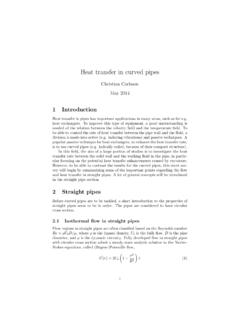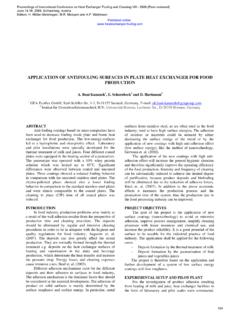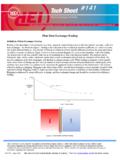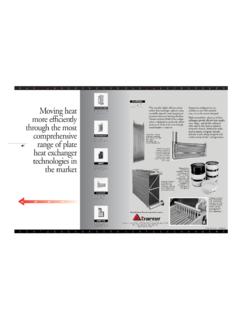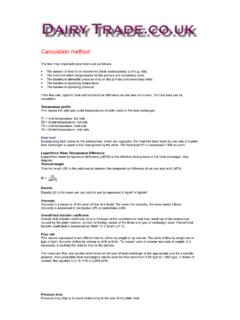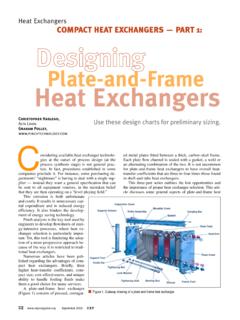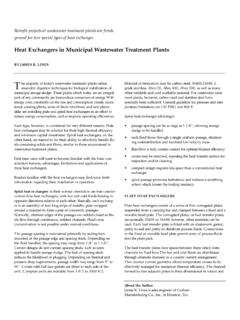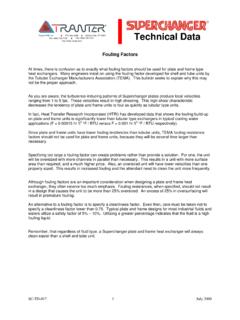Transcription of INTRODUCTION TO HEAT EXCHANGERS - …
1 INTRODUCTION TOHEAT EXCHANGERSB engt Sund nLund Institute of TechnologyWhat is aHeatExchanger?A heat exchangeris a devicethat is used to transfer thermal energy(enthalpy) between two or more fluids, between a solid surface and a fluid,or between solid particulates and a fluid,at different temperaturesand in thermal of heat exchangersHeat EXCHANGERS are classified according to Transfer process Number of fluids Degree of surface contact Design features Flow arrangements heat transfer mechanismsFig. 1 Fluidized-bed heat 2 heat transfer surface area density spectrum ofexchanger surfaces ( Shah, 1981).Fig. 3 (a) Shell-and- tube exchanger with one shell passand one tube pass;(b) shell-and- tube exchanger with one shell pass and two tube 4 Standard shell types and front- andrear-end head types (From TEMA, 1999).
2 Fig. 5 Gasketed plate-and-frame heat 6 Plates showing gaskets around the ports (Shah and Focke, 1988).Fig. 7 Section of a welded plate heat exchanger . Fig. 8 Bavex welded- plate heat 9 Spiral plate heat exchanger with both fluids in spiral counter 10 (a) Lamella heat exchanger ;(b) cross section of a lamella heat exchanger ,(c) lamellas Fig. 11 Printed-circuit cross flow exchangerFig. 12 Corrugated fin geometries for plate-fin heat EXCHANGERS :(a) plain triangular fin; (b) plain rectangular fin; (c) wavy fin; (d) offset strip fin; (e) multilouver fin; (f) perforated 13 (a) Individually finned tubes;(b) flat (continuous) fins on an array of 14 Individually fin 15 heat wheel or a rotary regenerator madefrom a polyester film.
3 Classification according to transfer processIndirect contact type Direct contact typeDirect transferStorage Fluidized bedImmiscible fluidsGas-liquid Liquid-vapourSingle-phaseMultiphaseClass ification according to number of fluidsTwo-fluidThree-fluidN-fluid (N > 3)Classification according to surface compactnessGas-to-liquidLiquid-to-liquid and phase-changeCompact 700 m2/m3 Non-compact < 700 m2/m3 Compact 400 m2/m3 Non-compact < 400 m2/m3 Classification according to design or typeTubularPlate-typeExtended surfaceRegenerativePHES piralPlate coilPrinted circuitGasketedWeldedBrazedDouble-pipeSh ell-and-tube Spiral tubePipe coilsCross-flow to tubesParallel flowto tubesPlate-finTube-finOrdinary SeparatingwallHeat-pipewallRotaryFixed-m atrixRotatinghoodsClassification according to flow arrangements Single-pass MultipassCounter flowParallel flowCross flow Split flow Divided flowExtended surfaceCross-Counter flowCross-parallel flowCompound flowShell-and-tubePlateParallel counter flowm-shell passesn-tube
4 Passessplit-flowDivided-flow Fluid 1 m passesFluid 2 n passesClassification according to heat transfer mechanismsSingle-phase convection on both sidesSingle-phase convection on one side, Two-phase convection on other sideTwo-phase convection on both sidesCombined convection and radiative heat transfer Classification according to process function CondensersLiquid-to-vaporphase-changeexc hangers HeatersCoolersChillersConvective heat transferv ggFluid1 Fluid2 Overall heat transfer coefficientmm1tTRtUAQ = = Expression for overall thermalresistanceo oFvlwwiiFii1111oAAAbAATR + + + + =Values of the heat transfer coefficient W/m2K Air atmospheric pressure 5-75 Air pressurized 100 - 400 Water, liquid 500-20 000 Organic liquids 50 000 Boiling 2 500 -100 000 Condensation 3 000-100 000 Correlations for the heat transfer coefficient Nu = hL/k = function (flow velocity, physicalproperties, geometry) = function (Re, Pr, geometry)General research needs How to achieve more compact heat EXCHANGERS High thermal efficiency Balance between enhanced heat transfer and accompanied pressure drop Material issues especially for high temperatureapplications Manufacturing methodology Fouling Non-steady operatio
